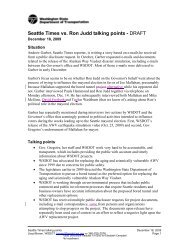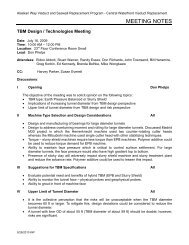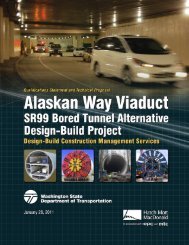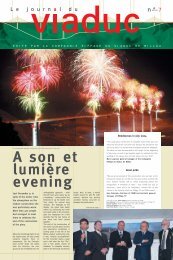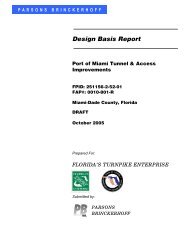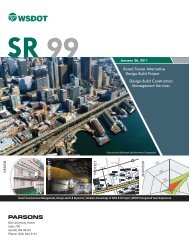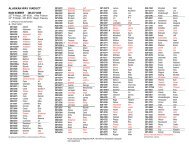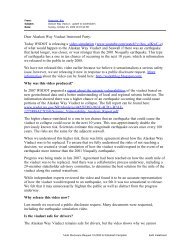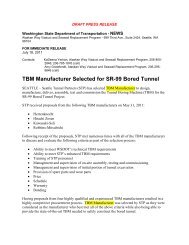SR99 Bored Tunnel-Assessment of Settlement Impacts ... - SCATnow
SR99 Bored Tunnel-Assessment of Settlement Impacts ... - SCATnow
SR99 Bored Tunnel-Assessment of Settlement Impacts ... - SCATnow
Create successful ePaper yourself
Turn your PDF publications into a flip-book with our unique Google optimized e-Paper software.
The information entered on the forms was sometimes based upon assumptionsregarding the structural systems for the building inferred from the building’s age,construction type, and observed conditions. Where the foundation system anddepth is not known, the assumption utilized in the calculations is noted on theforms. The forms are included as Appendix C with this report.3.5 Analytical <strong>Assessment</strong>For each building along the tunnel alignment, calculations were performed based onthe Boscardin and Cording [1989] (B&C) approach that relates the predictedhorizontal deformations and settlement pr<strong>of</strong>iles to differential settlement, angulardistortion, and/or tensile and shear strains. Each building was then assigned adamage classification based upon the calculated distortions and strains (see Section5). These values and classifications are provided on the Building <strong>Assessment</strong> Formsin Appendix C.It should be noted that the B&C analysis is based upon tunneling beneath oradjacent to an unreinforced masonry building supported on spread footings andsituated on a flat site. Therefore, this analysis is limited in applicability for thebuildings along the alignment. As will be noted in a review <strong>of</strong> the Building<strong>Assessment</strong> Forms, the buildings along the alignment utilize a variety <strong>of</strong> framingsystems and foundation types. This discrepancy between the analysis methodassumptions and the actual buildings has been considered in the qualitativeassessment <strong>of</strong> the building as described in Section 3.6.Subsequent to the analysis based upon the B&C approach, a number <strong>of</strong> thestructures were further evaluated utilizing structural engineering analysesmethodologies. These evaluations included the following:a. Two-dimensional frame analysis.b. Finite element analysis <strong>of</strong> walls.c. Son and Cording [2005] modifications to the B&C analysis.3.6 Qualitative <strong>Assessment</strong>Buildings within the zone <strong>of</strong> potential influence vary greatly in many ways. Duringthe site visits to each <strong>of</strong> the structures and as part <strong>of</strong> the subsequent review <strong>of</strong> theavailable construction documents, a number <strong>of</strong> items were noted that could affectthe building’s performance during tunneling operations. As a result, each <strong>of</strong> thebuildings along the alignment underwent a qualitative evaluation which included, butwas not limited to, the following:a. Condition <strong>of</strong> the building – based upon observed distress in the structure,foundations, interior finishes, and exterior finishes.The Alaskan Way Viaduct & Seawall Replacement Program March 2010Proposed SR 99 <strong>Bored</strong> <strong>Tunnel</strong> - <strong>Assessment</strong> <strong>of</strong> <strong>Settlement</strong> <strong>Impacts</strong> to Buildings 12Public Disclosure Request 11-0123 for Elizabeth Campbell - 2nd installment




